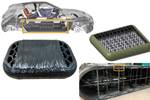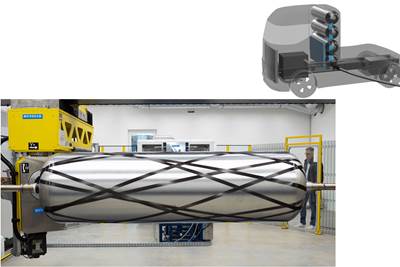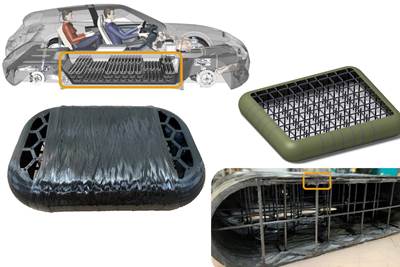Hi-DEN project targets novel high-pressure hydrogen storage innovations
Carbon ThreeSixty, alongside partners Antich & Sons and Viritech, will manufacture, integrate and demonstrate a volumetrically efficient composite hydrogen system for land transport, short-haul aerospace.
Share
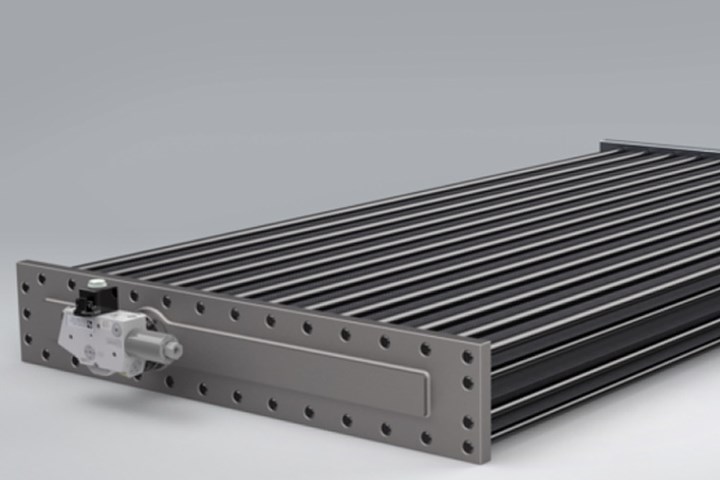
Hi-DEN storage systems. Photo Credit, all images: Carbon ThreeSixty
Carbon ThreeSixty (Chippenham, U.K.), a turnkey provider for the design, development and manufacture of highly challenging, advanced composite structures, is leading a project to develop a novel high-pressure hydrogen storage solution for use with fuel cell systems for land transport and short-haul aerospace.
The company’s high-density energy network (Hi-DEN) system will be based on volumetrically efficient arrays of “micro” hydrogen vessels to increase storage capacity, efficiency and vehicle range; essentially, the system is a vessel itself, made up of a connected series of smaller tubes. The idea is that Hi-DEN can be reconfigured depending on available space, Carbon ThreeSixty told CW. At present, the company has focused on making the system fit the underfloor space typically used for battery boxes, but it could also be shaped to fit front/rear compartments, where engines or fuel tanks would typically go. It could also work in the roof spaces used on buses.
Through this volumetric efficiency, storage volume is said to increase by up to 50% for irregularly shaped spaces, such as those typically used for vehicle petrol or diesel tanks, versus larger-diameter conventional composite-overwrapped pressure vessels (COPVs). Hydrogen capacity is eminently scalable, the company notes, but when compared to three conventional COPVs, for example, Carbon ThreeSixty expects to store 15-20% more hydrogen.
The system also offers improved gravimetric efficiency (kilogram/hydrogen, kilogram/structure), hence additional capacity and vehicle range do not come with a corresponding weight penalty. For volume manufacture the cost of hydrogen storage vessels is dominated by carbon fiber cost and “balance of plant” components. Improved material use efficiency therefore enables cost savings in material as well as use of space, Carbon ThreeSixty notes.
In terms of design, at present, each of the company’s mini tubes is required to be the same length. Otherwise, length, width and outer shape profile are flexible. The composite pressure vessel shown at top, for example, is 1.8 × 1 meter and 150 millimeters high.
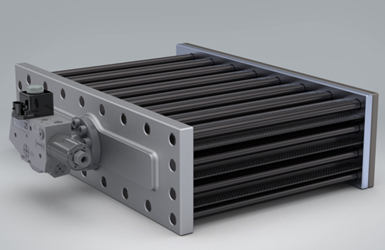
The Hi-DEN project will build and test a fully functional prototype hydrogen storage vessel. Carbon ThreeSixty is leading the project, completing the design and development of the hydrogen vessel via closed mold resin transfer molding (RTM). Antich & Sons (Huddersfield, U.K.) is responsible for developing 3D woven preforms for the design concept and Viritech (London, U.K.) will develop the tank and fill control system as well as integrate/demonstrate the system in its fuel cell electric vehicle (FCEV) powertrains and provide a route to market.
According to project partners, HiDEN tanks will integrate with standard refueling systems. Carbon ThreeSixty told CW that it will be monitoring temperatures throughout the structure during development to better understand thermal capability. After initial bench/lab testing, vehicle testing with Viritech is planned.
“We’re excited to be leveraging our composite expertise to bring innovation to the gaseous hydrogen storage space and to be able to improve the capability, range and ultimately commercial viability of FCEV vehicles,” Andy Smith, R&D director at Carbon ThreeSixty, says.
The project’s collaborative research and development (R&D) activities have been supported through grant funding provided by Innovate UK, delivered by the Niche Vehicle Network (NVN). NVN is a free-to join-networking and support organization focused on enabling U.K. low-volume vehicle manufacturers and design and engineering companies to research and develop innovative zero-emission vehicle technologies.
Related Content
Cutting 100 pounds, certification time for the X-59 nose cone
Swift Engineering used HyperX software to remove 100 pounds from 38-foot graphite/epoxy cored nose cone for X-59 supersonic aircraft.
Read MoreNext-gen fan blades: Hybrid twin RTM, printed sensors, laser shock disassembly
MORPHO project demonstrates blade with 20% faster RTM cure cycle, uses AI-based monitoring for improved maintenance/life cycle management and proves laser shock disassembly for recycling.
Read MoreCrashworthiness testing of composites: A building block approach, Part 2
Following the previously discussed coupon-level testing element, subcomponent and component testing are the next steps in designing crashworthy composite structures.
Read MoreOptimizing robotic winding of composite tanks and pipes
Pioneer in mandrel-based reinforced rubber and composite products, TANIQ offers TaniqWindPro software and robotic winding expertise for composite pressure vessels and more.
Read MoreRead Next
Cryo-compressed hydrogen, the best solution for storage and refueling stations?
Cryomotive’s CRYOGAS solution claims the highest storage density, lowest refueling cost and widest operating range without H2 losses while using one-fifth the carbon fiber required in compressed gas tanks.
Read MoreTU Munich develops cuboidal conformable tanks using carbon fiber composites for increased hydrogen storage
Flat tank enabling standard platform for BEV and FCEV uses thermoplastic and thermoset composites, overwrapped skeleton design in pursuit of 25% more H2 storage.
Read MoreScaling up, optimizing the flax fiber composite camper
Greenlander’s Sherpa RV cab, which is largely constructed from flax fiber/bio-epoxy sandwich panels, nears commercial production readiness and next-generation scale-up.
Read More


